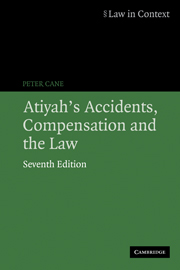Book contents
- Frontmatter
- Contents
- Preface
- List of abbreviations
- List of tables
- Table of legislation
- Table of cases
- Part One The Issues in Perspective
- Part Two The Tort System in Theory
- 2 Fault as a basis of liability
- 3 The scope of the tort of negligence
- 4 Departures from the fault principle
- 5 Causation and remoteness of damage
- 6 Damages for personal injury and death
- 7 An appraisal of the fault principle
- Part Three The Tort System in Operation
- Part Four Other Compensation Systems
- Part Five The Overall Picture
- Part Six The Future
- Index
5 - Causation and remoteness of damage
Published online by Cambridge University Press: 05 June 2012
- Frontmatter
- Contents
- Preface
- List of abbreviations
- List of tables
- Table of legislation
- Table of cases
- Part One The Issues in Perspective
- Part Two The Tort System in Theory
- 2 Fault as a basis of liability
- 3 The scope of the tort of negligence
- 4 Departures from the fault principle
- 5 Causation and remoteness of damage
- 6 Damages for personal injury and death
- 7 An appraisal of the fault principle
- Part Three The Tort System in Operation
- Part Four Other Compensation Systems
- Part Five The Overall Picture
- Part Six The Future
- Index
Summary
Introduction
A person cannot incur tort liability to pay damages for injury or damage suffered by another unless that injury or damage was caused by the former's tortious conduct. This is as true of strict tort liability as it is of fault-based tort liability. Causation of harm is essential to tort liability because tort law is a set of principles of personal responsibility for conduct. Tort law compensates the injured, but only if someone else was responsible for those injuries; and normally a person will not be responsible for injuries unless their conduct caused the harm. In other words, the tort system is a ‘cause-based’ compensation system. These deceptively straightforward statements raise complex issues which are usually dealt with by considering two questions: first, did the tortious conduct in fact cause the damage? Secondly, whatever the answer to the first question, ought the tortfeasor to be held liable for the loss suffered by the injured person? If the answer to the first question is ‘no’, then the answer to the second will usually, but not invariably, also be negative. But answering the first question affirmatively by no means always leads to the imposition of liability. The reason for this is expressed by the courts in a variety of ways: sometimes by saying that the damage was not foreseeable; sometimes by saying it was too ‘remote’; sometimes by saying the damage suffered is not of a kind recognized by the law; sometimes by saying that the defendant's negligence was not the ‘real’ or ‘proximate’ cause of the damage.
- Type
- Chapter
- Information
- Atiyah's Accidents, Compensation and the Law , pp. 110 - 129Publisher: Cambridge University PressPrint publication year: 2006

